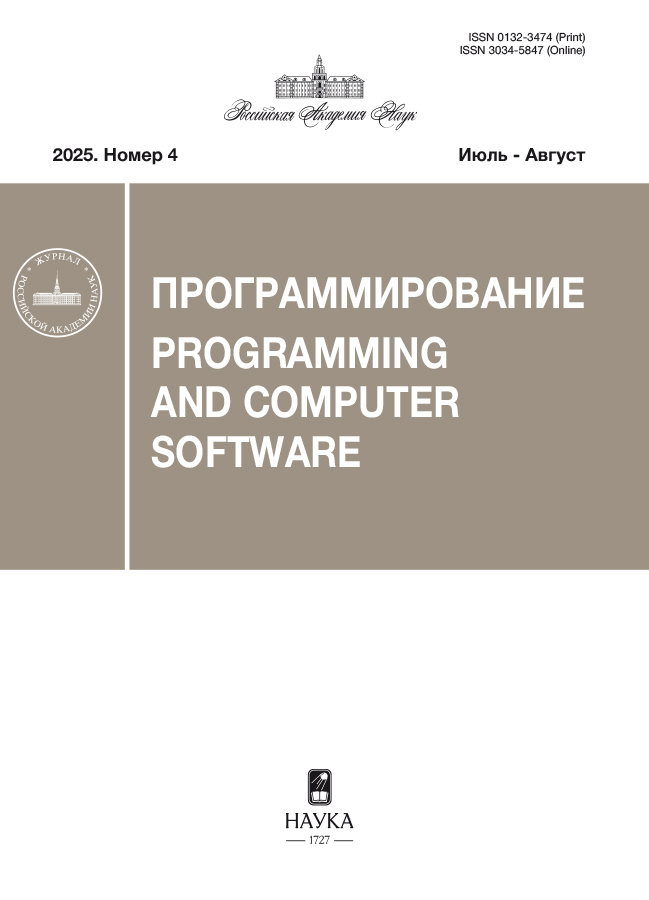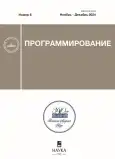Оптимизация быстродействия программного обеспечения реализации алгоритмов классификации и привязки деловых документов
- Авторы: Славин О.А.1,2
-
Учреждения:
- Федеральный исследовательский центр “Информатика и управление” РАН
- ООО “Смарт Энджинс Сервис”
- Выпуск: № 6 (2024)
- Страницы: 48-58
- Раздел: АНАЛИЗ ДАННЫХ
- URL: https://journal-vniispk.ru/0132-3474/article/view/283186
- DOI: https://doi.org/10.31857/S0132347424060057
- EDN: https://elibrary.ru/dykmmm
- ID: 283186
Цитировать
Аннотация
В работе рассматриваются технологии оптимизации быстродействия программного обеспечения. Методы оптимизации подразделяются на высокоуровневые и низкоуровневые, а также на распараллеливание. Описываемые методы оптимизации применяются к программам и программным системам, реализующим разнообразную обработку информации, в которых неэффективность использования аппаратных ресурсов может присутствовать в большом числе горячих точек. Как пример приведен алгоритм классификации и привязки полей в распознанном образе делового документа. Перечисляются особенности реализации задач классификации и привязки, состоящие в применении созвездий особых текстовых точек и модифицированного расстояния Левенштейна, В качестве OCR была использована система SDK Smart Document Engine и Tesseract. Описано несколько способов оптимизации быстродействия функций классификации и привязки содержимого документа. Также описана оптимизация быстродействия системы сортировки потока изображений деловых документов. Предлагаемые методы оптимизации быстродействия программного обеспечения пригодны не только для реализации алгоритмов обработки изображений, но и для вычислительных алгоритмов, в которых проводится циклическая обработка информации большого объема.
Ключевые слова
Полный текст
Об авторах
О. А. Славин
Федеральный исследовательский центр “Информатика и управление” РАН; ООО “Смарт Энджинс Сервис”
Автор, ответственный за переписку.
Email: oslavin@isa.ru
Россия, 119333 Москва, ул. Вавилова, 44/2; 117312 Москва, проспект 60-летия Октября, 9
Список литературы
- Acar U.A., Blelloch G.E., Harper R. Selective memorization. ACM SIGPLAN Notices. 2003. V. 38. № 1. P. 14–25. https://doi.org/10.1145/640128.604133
- Tatarowicz A.L., Curino C., Jones E.P.C. and Madden S. Lookup Tables: Fine-Grained Partitioning for Distributed Databases. IEEE28th International Conference on Data Engineering. 2012. P. 102–113. https://doi.org/10.1109/ICDE.2012.26
- Harris D.M., Harris S.L. Digital Design and Computer Architecture, 2nd Edition. Morgam Kaufmann is an imprint of Elsevier Inc., Waltham, 2013. 720 p.
- Rusiñol M., Frinken V., Karatzas D., Bagdanov A.D., Lladós J. Multimodal page classification in Administrative document image streams. In: IJDAR. 2014. V. 17. № 4. P. 331–341. https://doi.org/10.1007/s10032-014-0225-8
- Slavin O.A., Pliskin E.L. Method for analyzing the structure of noisy images of administrative documents. Bulletin of the South Ural State University. Ser. Mathematical Modelling, Programming & Computer Software (Bulletin SUSU MMCS). 2022. V. 15. № 4. P. 80–89. https://doi.org/10.14529/mmp220407
- Slavin O.A., Farsobina V., Myshev A.V. Analyzing the content of business documents recognized with a large number of errors using modified Levenshtein distance. Cyber-Physical Systems: Intelligent Models and Algorithms. Springer Nature Switzerland AG. 2022. V. 417. P. 267–279. https://doi.org/10.1007/978-3-030-95116-0
- Bellavia F. SIFT Matching by Context Exposed. IEEE Transactions on Pattern Analysis and Machine Intelligence. 2022. https://doi.org/10.1109/TPAMI.2022.3161853
- Bay H., Tuytelaars T., Van Gool Luc. SURF: Speeded Up Robust Features. Computer Vision and Image Understanding – CVIU. 2003. V. 110. № 3. P. 404–417.
- Du X., Wumo P., Bui T.D. Text line segmentation in handwritten documents using Mumford–Shah model. Pattern Recognition. 2009. V. 42. P. 3136–3145. https://doi.org/10.1016/j.patcog.2008.12.021
- Maraj A., Martin M.V., Makrehchi M. A More Effective Sentence-Wise Text Segmentation Approach Using BERT. In: Lladós J., Lopresti D., Uchida S. (eds) Document Analysis and Recognition – ICDAR2021. Lecture Notes in Computer Science, Springer, Cham. 2021. V. 12824. https://doi.org/10.1007/978-3-030-86337-1_16
- Kravets A.G., Salnikova N.A., Shestopalova E.L. Development of a Module for Predictive Modeling of Technological Development Trends. Cyber-Physical Systems. 2021. P. 125–136. https://doi.org/10.1007/978-3-030-67892-0_11
- Sabitov A., Minnikhanov R., Dagaeva M., Katasev A., Asliamov T. Text Classification in Emergency Calls Management Systems. Cyber-Physical Systems. 2021. P. 199–210. https://doi.org/10.1007/978-3-030-67892-0_17
- Deza M.M., Deza E. Encyclopedia of distances. Springer-Verlag, Berlin, xiv+590 pp. (2009)
- Yujian L., Bo L. A Normalized Levenshtein Distance Metric // IEEE Transactions on Pattern Analysis and Machine Intelligence. V. 29. № 6. P. 1091–1095. https://doi.org/10.1109/TPAMI.2007.1078 (2007)
- Intel® VTune™ Profiler Performance Analysis Cookbook. https://www.intel.com/content/www/us/en/docs/vtune-profiler/cookbook/2023–2/overview.html. Accessed 23 Sep. 2023.
- Smart Document Engine – automatic analysis and data extraction from business documents for desktop, server and mobile platforms. https://smartengines.com/ocr-engines/document-scanner. Accessed 23 Sep. 2023.
- Intel(R) oneAPI Threading Building Blocks (oneTBB) Developer Guide and API Reference. https://www.intel.com/content/www/us/en/docs/onetbb/developer-guide-api-reference/2021–10/overview.html. Accessed 23 Sep. 2023.
- OCR Tesseract. https://github.com/tesseract-ocr/tesseract. Accessed 23 Sep. 2023.
- NIST Special Database. https://www.nist.gov/srd/nist-special-database-2. Accessed 23 Sep. 2023.
- Tobacco-3482. https://www.kaggle.com/patrickaudriaz/tobacco3482jpg. Accessed 23 Sep. 2023.
- Kravets A.G., Egunov V. The Software Cache Optimization-Based Method for Decreasing Energy Consumption of Computational Clusters // Energies [Special Issue Smart Energy and Sustainable Environment]. 2022. V. 15. № 20. P. 7509. https://doi.org/10.3390/en15207509
- Crow F.C. Summed-area tables for texture mapping ACM SIGGRAPH Computer Graphics. 1984. V. 18. № 3. P. 207–212.
- Trusov A., Limonova E., Nikolaev D., Arlazarov V.V. 4.6-bit Quantization for Fast and Accurate Neural Network Inference on CPUs // Mathematics. 2024. V. 12. № 5. P. 651. https://doi.org/10.3390/math12050651
- Rybakova E.O., Limonova E.E., Nikolaev D.P. Fast Gaussian Filter Approximations Comparison on SIMD Computing Platforms // Applied Sciences. 2024. V. 14. № 11. P. 4664. https://doi.org/10.3390/app14114664













